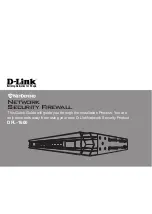
44
Chapter 5: Configuring Device Security
Defining 802.1x
SFE1000P Gigabit Ethernet Switch Reference Guide
Chapter
5
Defining 802.1x
Port based authentication enables authenticating system users on a per-port basis via a external
server. Only authenticated and approved system users can transmit and receive data. Ports are
authenticated via the RADIUS server using the Extensible Authentication Protocol (EAP). Port
Authentication includes:
•
Authenticators
— Specifies the port, which is authenticated before permitting system access.
•
Supplicants
— Specifies host connected to the authenticated port requesting to access the
system services.
•
Authentication Server
— Specifies the external server, for example, the RADIUS server that
performs the authentication on behalf of the authenticator, and indicates whether the
supplicant is authorized to access system services.
Port based authentication creates two access states:
•
Controlled Access
— Permits communication between the supplicant and the system, if the
supplicant is authorized.
•
Uncontrolled Access
— Permits uncontrolled communication regardless of the port state.
The 802.1x page configures port to use Extensible Authentication Protocol (EAP).
The 802.1x section contains the following pages:
• Defining 802.1X Properties
• Defining Port Authentication
• Defining Multiple Hosts
• Defining Authenticated Host
Defining 802.1X Properties
Port based authentication enables authenticating system users on a per-port basis via a external
server. Only authenticated and approved system users can transmit and receive data. Ports are
authenticated via the RADIUS server using the Extensible Authentication Protocol (EAP). Port
Authentication includes:
•
Authenticators
— Specifies the port, which is authenticated before permitting system access.
•
Supplicants
— Specifies host connected to the authenticated port requesting to access the
system services.
•
Authentication Server
— Specifies the external server, for example, the RADIUS server that
performs the authentication on behalf of the authenticator, and indicates whether the
supplicant is authorized to access system services.
Port based authentication creates two access states:
















































